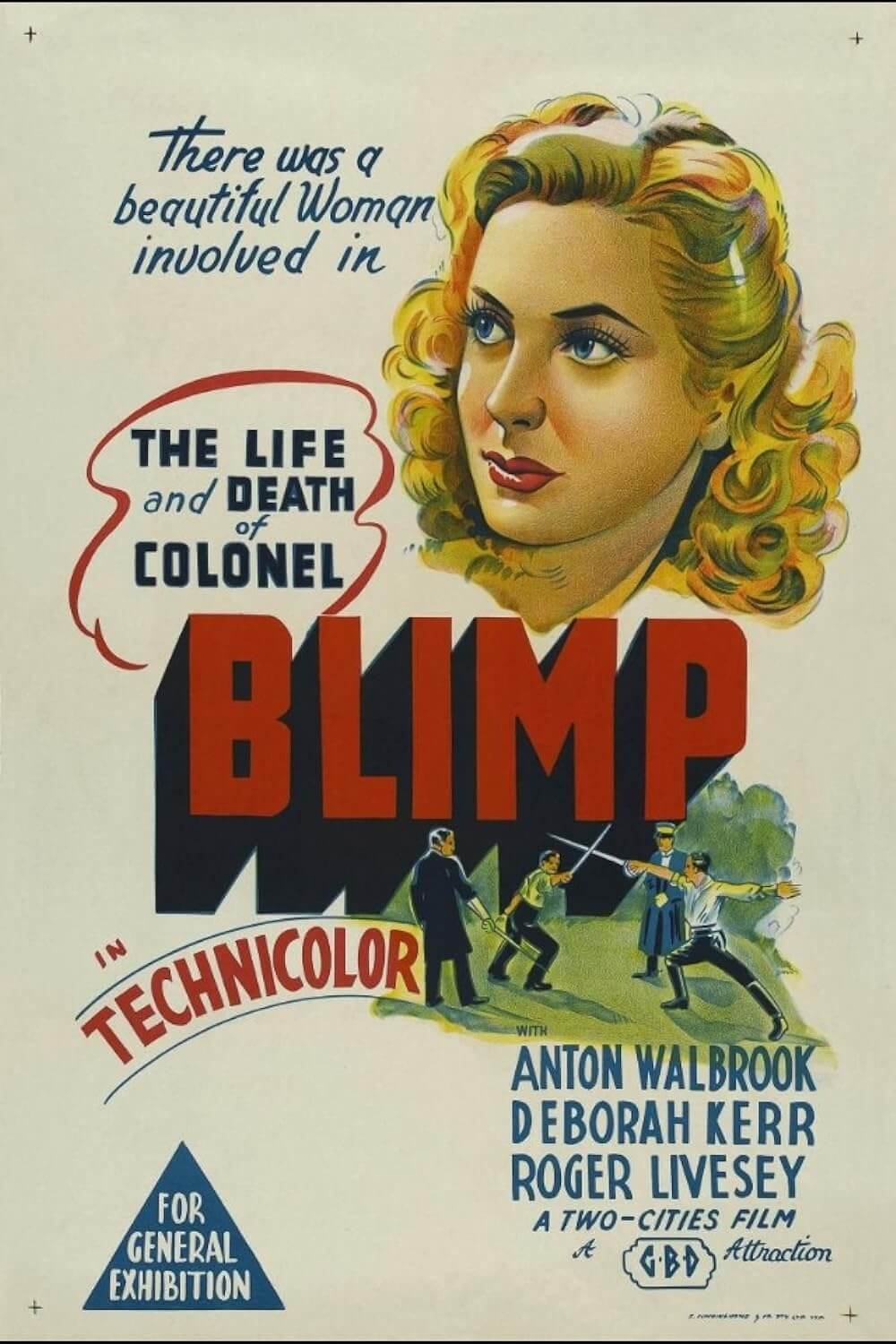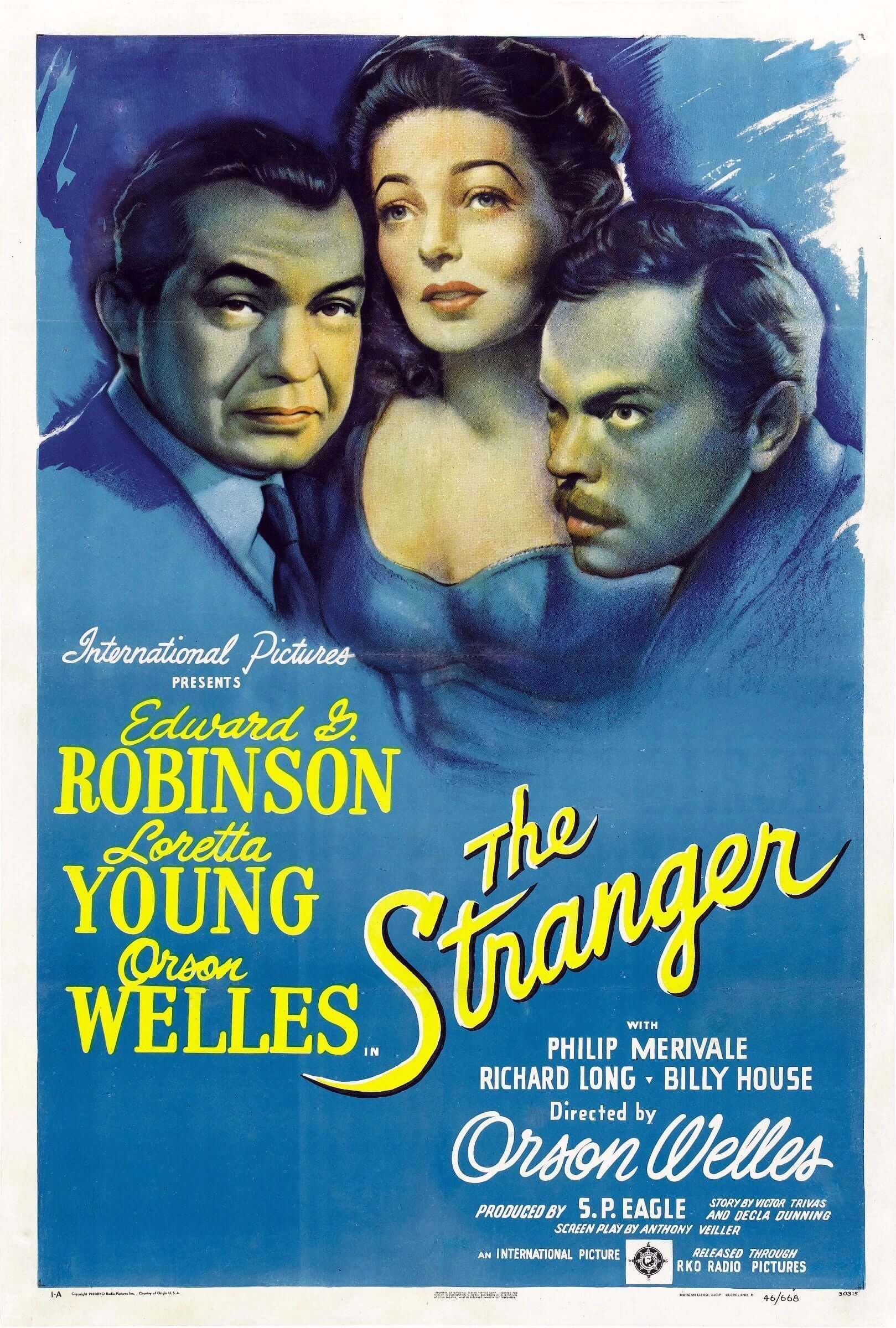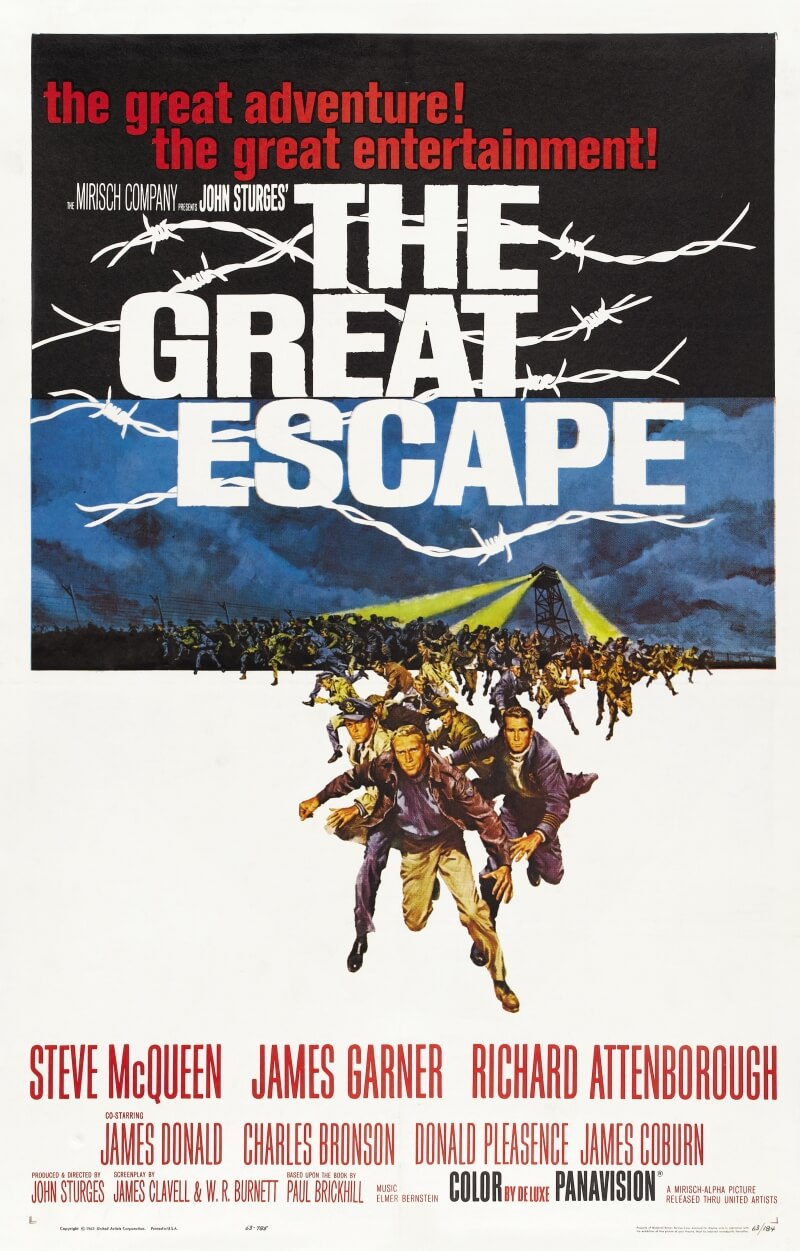Reader's Choice
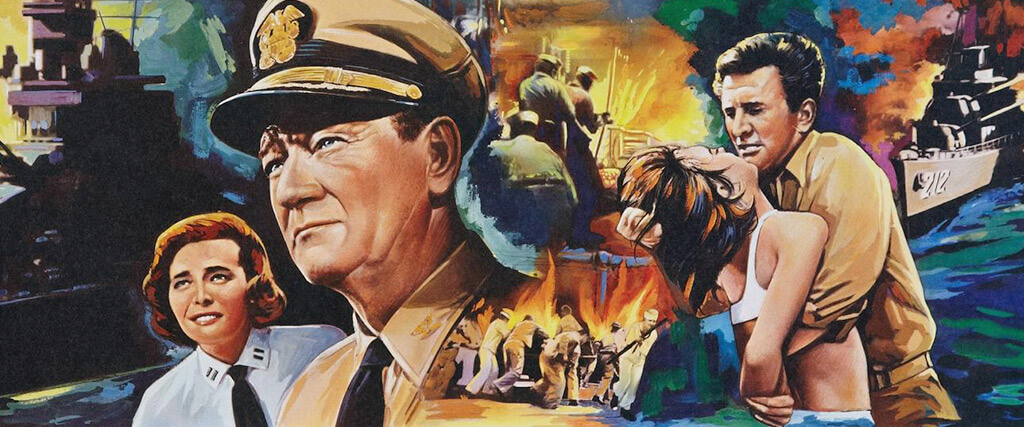
In Harm’s Way
By Brian Eggert |
Academics and critics often debate when Hollywood’s Golden Age started and ended, offering detailed arguments and justifications. Historian Richard Jewell neatly contains this period of Classical Hollywood cinema between 1929 to 1945, bookending the era between the Great Depression and the end of the Second World War. Citing the modes of production and formal techniques used by Hollywood studios to produce such films, David Bordwell and Kristin Thompson argue the Golden Age extends as late as 1960. Nevertheless, the tone, setting, and unabashed optimism of Otto Preminger’s In Harm’s Way, released in 1965, supplies a late example of the Classical Hollywood style, with a few details and subplots that deploy exceptions. It’s a patriotic Naval film about American men being men, following orders, operating American machines, following a Naval morality, and doing what they must to get the job done. Questions of human desire come second to serving the institution of the United States Navy. More than that, with its right-wing politics and valorization of American GIs, it embodies the quintessential on- and off-screen persona of its star, John Wayne.
The film debuted two decades after the end of the Second World War, long after Hollywood stopped making prowar pictures to support the war effort. In the years immediately following the Allied victory, filmmakers weighed the human toll and exposed the horrors of war. Titles such as The Best Years of Our Lives (1946) and The Bridge on the River Kwai (1957), set against the backdrop of WWII, told stories with an antiwar slant to the conflict. In 1953, Fred Zinnemann’s landmark From Here to Eternity mourned the lives lost and personal sacrifices of the average GIs stationed on Oahu before the Japanese attack on Pearl Harbor in 1941. It was a sobering melodrama and eight-time Oscar winner, including Best Picture and Best Director. But time healed the wounds of war by 1965, and the human tragedy of WWII was replaced with Hollywoodized action. The war became a pretense for adventure stories and patriotism, delivering titles like The Guns of the Navarone (1961) and The Great Escape (1963). 1965 alone brought Battle of the Bulge, Von Ryan’s Express, The Heroes of Telemark, and Operation Crossbow.
As Hollywood’s criticism softened, wartime adventures used the material to bolster the myth of the USA as the greatest country in the world that won The Good War, favoring a message about a righteous and heroic victory. (Nevermind that it took the Japanese attack to compel America out of its isolationism, which happened several years after the war had started and its atrocities had spread throughout Europe and Asia.) In Harm’s Way is a perfect example of this message, with Preminger seeking, according to Willi Frischauer’s book Behind the Scenes of Otto Preminger, to create a hero-worshipping testament to the Navy. “After all these war films which seem to have been more defeatist than pacifist,” said Preminger, “the Navy needs a film like this!” What better way to achieve this than adapt James Bassett’s best-selling novel? It would be a change of pace for the director, who set aside his film noirs of the 1940s and taboo-breaking antics of the late 1950s for a traditional, gung-ho picture—a film whose ideology takes not-so-subtle cracks at east coast intellectuals and “Roosevelt’s war,” while acknowledging that a Naval officer’s duty comes before any other concerns.
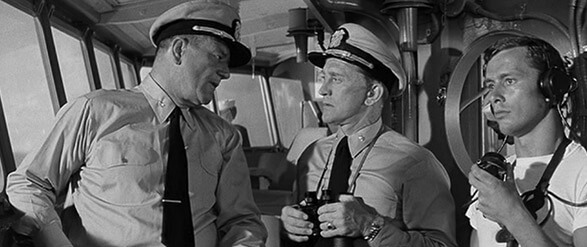 Similar to From Here to Eternity, Preminger’s film weaves together romance, GI politics, history, and dramatic irony into a film that fictionalizes real-life events. Although the story involves the attack on Pearl Harbor, followed by the Pacific campaigns in New Guinea, Bougainville, and Guadalcanal, the film changes the names of the Solomon Islands. In Harm’s Way is less concerned with the facts or even the tragedy of these events; it’s much more invested in Naval duty and honor. The story centers on career Navyman Captain Rockwell Torrey (Wayne), nicknamed “Rock” of course, who serves on a destroyer along with his beleaguered number two, Commander Paul Eddington (Kirk Douglas). Wayne plays Rock with his sturdy, impenetrable style intact—a far cry from his wounded and vulnerable heroes from The Searchers (1956) and Rio Bravo (1959). Rock is married to the Navy, to the extent that he left his wife and child several years earlier to fulfill his duty. “He’s all Navy and nothin’ but Navy,” remarks a sailor. And the film’s outlook aligns with Rock’s, in that any civilian matters of family or love come secondary to the Navy institution.
Similar to From Here to Eternity, Preminger’s film weaves together romance, GI politics, history, and dramatic irony into a film that fictionalizes real-life events. Although the story involves the attack on Pearl Harbor, followed by the Pacific campaigns in New Guinea, Bougainville, and Guadalcanal, the film changes the names of the Solomon Islands. In Harm’s Way is less concerned with the facts or even the tragedy of these events; it’s much more invested in Naval duty and honor. The story centers on career Navyman Captain Rockwell Torrey (Wayne), nicknamed “Rock” of course, who serves on a destroyer along with his beleaguered number two, Commander Paul Eddington (Kirk Douglas). Wayne plays Rock with his sturdy, impenetrable style intact—a far cry from his wounded and vulnerable heroes from The Searchers (1956) and Rio Bravo (1959). Rock is married to the Navy, to the extent that he left his wife and child several years earlier to fulfill his duty. “He’s all Navy and nothin’ but Navy,” remarks a sailor. And the film’s outlook aligns with Rock’s, in that any civilian matters of family or love come secondary to the Navy institution.
The film opens on December 6, 1941, and, over the two-hour-and-forty-five-minute runtime, explores the institutional and private lives of its characters between the attack on Pearl Harbor to a decisive Naval victory in the South Pacific. Following Pearl Harbor, Rock and company lick their wounds, some literal, while Admiral Broderick (Dana Andrews) leads the offensive against Japan. But Broderick’s lack of progress incites his commander (Henry Fonda) to promote Rock to Admiral and give him the job. Joining Rock overseas are his erratic friend, Eddington; Commander Egan Powell (Burgess Meredith), Rock’s roommate, an old codger and former Hollywood screenwriter turned Naval intelligence officer; and Lieutenant Maggie Haynes (Patricia O’Neal), a nurse with whom Rock has formed a romance before being called into duty. Also on the personal side, Rock meets his son, Jere (Brandon De Wilde), an Ensign who at first proves to be a disappointment given his desire to enter public relations and politics. Steadily, Rock leads the USA to victory and, despite many causalities and the loss of his leg, he continues to fight where duty calls.
Setting aside an impressive cast and several unmentioned subplots, this is John Wayne’s show, in the sense that Rock—and much to the public’s awareness, Wayne himself—personifies the mentality of the American military. It’s an attitude exemplified by the smile on Rock’s face when Eddington exclaims, “Looks like we’ve got another war—a gut-busting, mother-loving Navy war!” Sociopolitical and global contexts remain unimportant to In Harm’s Way, and in a sense, the specificity of Pearl Harbor, beyond its use in the opening to bond the audience to the characters, is inconsequential. The film’s priorities are evident in the editing. Watch how Preminger skips over several days or months between cuts, excising seemingly important personal developments. In an earlier sequence, Rock breaks his arm, appears in a cast, and then has a healed, albeit tender arm in a matter of a few seconds of screentime. By contrast, the director spends several minutes of screentime showing Naval processes. Take Eddington’s arrival in the South Pacific: We see him land by seaplane, transfer to a boat that docks, where he then travels by jeep to the command center to meet Rock—the journey, pointless to the story, is delivered in a series of long procedural shots with an almost fetishistic attention to the vehicles and Naval efficiencies involved. The form in In Harm’s Way reflects Rock, and by extension the Navy mentality itself, in that the highlights of Rock’s ever-flowing career are those of a Navyman—the personal consequences are peripheral, treated with stoicism, whereas his responsibilities are to his orders.
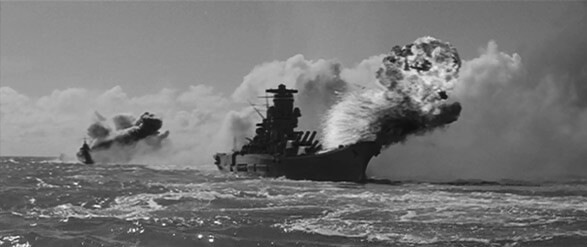 The production looks impressive for much of the picture. Cinematographer Loyal Griggs, who received the film’s only Oscar nomination, shoots in black-and-white on Panavision cameras, lending an epic visual treatment. Preminger had the support of the US Defense Department for the use of ships, planes, cruisers, and even transportation—the cast and crew traveled from Seattle to Hawaii aboard the USS St. Paul, on which Preminger shot a number of authentic-looking scenes. Those scenes appear genuine and impressive in scope, even today. The Pearl Harbor sequence in the opening employs a minimum of Hollywood artifice; instead, the audience sees real people interacting with real equipment, and those are real Japanese planes flying overhead, and real explosions, both of buildings and in the water. Despite the incredible pyrotechnics on display, the sequence hardly captures the scope of loss. Showing the full damage of the attack would be too much for Americans rooted in their postwar patriotism. Less impressive are the later battles, including a submarine attack that employs miniatures in studio water tanks, or the rear-projection shots used in the final, chaotic shootout between battleships, which also uses stock footage and obvious scale models.
The production looks impressive for much of the picture. Cinematographer Loyal Griggs, who received the film’s only Oscar nomination, shoots in black-and-white on Panavision cameras, lending an epic visual treatment. Preminger had the support of the US Defense Department for the use of ships, planes, cruisers, and even transportation—the cast and crew traveled from Seattle to Hawaii aboard the USS St. Paul, on which Preminger shot a number of authentic-looking scenes. Those scenes appear genuine and impressive in scope, even today. The Pearl Harbor sequence in the opening employs a minimum of Hollywood artifice; instead, the audience sees real people interacting with real equipment, and those are real Japanese planes flying overhead, and real explosions, both of buildings and in the water. Despite the incredible pyrotechnics on display, the sequence hardly captures the scope of loss. Showing the full damage of the attack would be too much for Americans rooted in their postwar patriotism. Less impressive are the later battles, including a submarine attack that employs miniatures in studio water tanks, or the rear-projection shots used in the final, chaotic shootout between battleships, which also uses stock footage and obvious scale models.
Elsewhere, more than fifty years later, the viewer cannot watch In Harm’s Way without considering the film’s shocking, oddly casual mistreatment of women—especially in an unfortunate subplot involving a male predator and rape. The theme begins in the first scenes at a naval party on Oahu, where Eddington’s wife (Barbara Bouchet) appears soused and dancing with a major (Hugh O’Brian) who couldn’t care less that she’s married. The next day, the two appear naked on a beach, having spent the night together. Just then, the Japanese attack Pearl Harbor, and the two adulterers die in a blaze of fire on the road. Meanwhile, Eddington, who’s lost himself to alcohol due to his wife’s philandering, feels relieved by her sudden absence. “All your personal problems resolved?” asks Rock. Smiling, Eddington replies, “Let’s just say they’re cut down to size.” From then onward, Eddington takes a post with less responsibility—he lives a bohemian lifestyle, using women wherever he goes. He grows a beard and settles in a Tahitian brothel. In one scene, he arrives on a naval boat carrying nurses and asks, “Is this the Admiral’s harem?” It’s worth questioning how Eddington’s treatment of women played in 1965, though looking back, few film critics at the time mention his behavior.
Eddington isn’t the sole misogynist, but he’s the worst of them. Consider Ensign Torrey’s rather predatory maneuvering to be alone with a young nurse, Annalee (Jill Haworth), at which point he makes his move, and then becomes aggressive with her. Regardless of her later agreeing to be the Ensign’s fiancée, Annalee does not escape sexually aggressive men. And it’s this aspect of In Harm’s Way that makes it troublesome. Later in the story, after Annalee shared an amorous glance or two with Eddington, he pushes himself on her. After he rapes her in a disturbing scene, she feels shame and fears herself pregnant, and then kills herself by swallowing pills. Maggie and Rock seem to know what happened and why. Even so, Rock keeps the truth from his son. “Whatever the reason, she was thinking of you,” he explains, which is no explanation at all. In essence, Rock covers up a rape to protect his friend, Eddington, who then, out of guilt, steals a reconnaissance plane to sacrifice himself for information that leads to an American Naval victory. In Navy morality, Eddington’s sacrifice means he earns a clean slate, while Rock issues his own punishment: he refuses to nominate Eddington for a medal. And what of poor Annalee, rape and suicide victim? What of Ensign Torrey’s broken heart and confusion over his fiancée’s suicide? These issues matter not to the Navy.
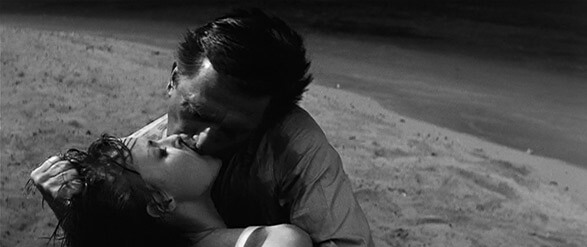 Neither women nor the face of the enemy concern Preminger. The Japanese, referred to throughout in an excessive (but probably realistic) use of “Japs” and “Nips,” remain an anonymous adversary. Just a single, blink-and-you’ll-miss-it scene shows a small group of Japanese soldiers; otherwise, the audience sees only the result of their violent actions against American Naval forces. Explosions and death result from nameless, faceless villains, removing all geopolitical or wartime contexts for the viewer, and thus allowing for a maximum glorification of Naval institutions. Similarly, as mentioned above, the specificity of Pearl Harbor or the battles of Guadalcanal are inconsequential to the film’s testament to the Navy. And perhaps because of that singular motive, In Harm’s Way was divisive among critics upon its release. A few praised it, such as The New Yorker critic Brendan Gill, who wrote, “The picture lasts two hours and forty-five minutes, nearly every one of which is filled with storm and stress.” The critic in Variety acknowledged, “This picture was tailored for John Wayne,” and meant that as a compliment. But Bosley Crowther made a similar observation in his New York Times review, and he meant it in a pejorative sense.
Neither women nor the face of the enemy concern Preminger. The Japanese, referred to throughout in an excessive (but probably realistic) use of “Japs” and “Nips,” remain an anonymous adversary. Just a single, blink-and-you’ll-miss-it scene shows a small group of Japanese soldiers; otherwise, the audience sees only the result of their violent actions against American Naval forces. Explosions and death result from nameless, faceless villains, removing all geopolitical or wartime contexts for the viewer, and thus allowing for a maximum glorification of Naval institutions. Similarly, as mentioned above, the specificity of Pearl Harbor or the battles of Guadalcanal are inconsequential to the film’s testament to the Navy. And perhaps because of that singular motive, In Harm’s Way was divisive among critics upon its release. A few praised it, such as The New Yorker critic Brendan Gill, who wrote, “The picture lasts two hours and forty-five minutes, nearly every one of which is filled with storm and stress.” The critic in Variety acknowledged, “This picture was tailored for John Wayne,” and meant that as a compliment. But Bosley Crowther made a similar observation in his New York Times review, and he meant it in a pejorative sense.
Wayne, though he never enlisted for service in the US military unlike many others in Hollywood, nevertheless maintained the air of a fighter, reliable and unbeatable. During the filming of In Harm’s Way, he had been unknowingly suffering from lung cancer, and so he looks tired, a bit more lumbering than usual. His eyes look like two slits packed with slabs of raw meat. Preminger used Wayne and his persona to achieve his message about the Navy, and the message, like Wayne himself, is big, imposing, and unmistakable. More than the human drama or wartime action, In Harm’s Way exists as a commendation to the Navy—not to their sacrifice in Pearl Harbor or the success of the South Pacific campaigns, which were glossed over in their detail, but as a general tribute. However, cinematic praise to any branch of the military, whether it’s in peacetime or in the midst of a war—the Vietnam War was in full swing in 1965—brings into question the politics and purpose of such a film. Certainly at the time, and today, the film rings of propaganda. That in itself is not a dismissible offense, as plenty of superb wartime propaganda films emerged during WWII. However, the overarching message of In Harm’s Way gets in the way of providing three-dimensional characters or a drama that engages the viewer’s emotions, beyond patriotic flag-waving.
(Editor’s Note: This review was commissioned on Patreon. Thank you for your support, Ron!)
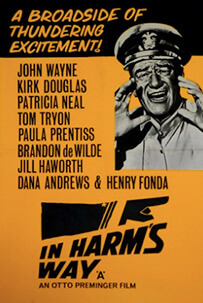
Unlock More from Deep Focus Review
To keep Deep Focus Review independent, I rely on the generous support of readers like you. By joining our Patreon community or making a one-time donation, you’ll help cover site maintenance and research materials so I can focus on creating more movie reviews and critical analysis. Patrons receive early access to reviews and essays, plus a closer connection to a community of fellow film lovers. If you value my work, please consider supporting DFR on Patreon or show your support in other ways.
Thank you for your readership!
Brian Eggert | Critic, Founder
Deep Focus Review


